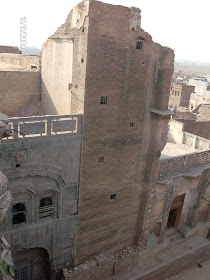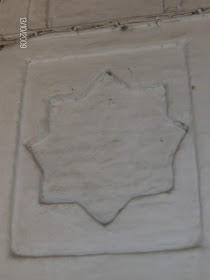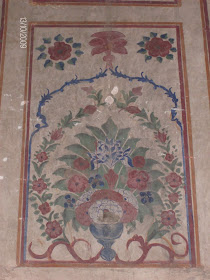By 1750 Mughal power in Punjab was rapidly collapsing and within a few years, Mughals lost their control over Punjab completely to Sikhs in central and eastern Punjab and to Afghans in western and southern Punjab. The whole area between Jamuna and Indus was in anarchy and divided into dozens of petty states and Sikhs Misls.
In 1748 Mir Moin ul Mulk, also known as Mir Mannu was appointed the governor of Lahore, his vigorous steps kept the depredations of Sikhs largely in control. He destroyed their fort Ram Rouni near Amritsar and thousands of Sikhs were captured and executed at Shaheed Ganj outside Delhi gate, Lahore. However, Sikhs were not the only problem, a bigger threat was Ahmad Shah Abdali of Afghanistan. He invaded Punjab seven times, starting in 1748, and caused widespread destruction and pillage during his invasions. Mir Mannu himself was defeated by Abdali in 1752. Though re-instated as governor, his power was broken. Without any help and support from Delhi darbar, he could not resist Abdali for long. His rule lasted just a few years and after him Adina Beg, the new governor tried to establish order in Punjab. The last invasion of Abdali was in 1767, these seven campaigns totally destroyed the influence and authority of Mughals in Punjab. However, Abdali failed to stem the rising tide of Sikhs and large parts of central and eastern Punjab fell to Sikhs including the capital Lahore in 1764 (during his last invasion Abdali took Lahore for a short period). Western and southern Punjab came under the rule of Afghans. But Afghan control was weak and after the death of Abdali in 1772 it became nominal. In this chaotic situation, dozens of Muslim principalities emerged in these areas, including Kasur, Jhang, Sial, Bahawalpur, Multan, Khushab, Sahiwal, Mitha Tiwana, Salt Range, and Mankera. These all states by 1822 fell to the rising power of Maharaja Ranjit Singh.
One of these states was Mankera. It was a big state between River Jhelum / Chenab and Indus. The town situated in the middle of vast Thal desert, in Sindh Sagar Doab is an ancient town. Due to its strong mud fort and geography, was considered a very strong point and very difficult to subjugate. It was the capital of a big state spread on both sides of the Indus river. It was under the nominal suzerainty of Afghanistan but was practically an independent state, ruled by an Afghan clan.
Towards the end of 18th century, Ranjit Singh of Gujranwala, the chief of Sukerchakia Misl, emerged as the main force in Punjab. He captured Lahore in 1799 and laid the foundations of a strong state. Soon he embarked upon a series of conquests, territories of other Sikh Misls and small Muslim states scattered all over Punjab were his target. By 1819 he had conquered almost the whole of present day Pakistani Punjab, Kashmir and the Bist Doab.
Ranjit Singh was a very energetic man and relentlessly launched campaigns in all direction to extract tributes from different chiefs or reduce their states altogether. Famous historian Syad Muhammad Latif, in his History of Panjab, published in 1889, gives the following account of the Ranjit Singh's first campaign again Mankera in his book, this campaign started in 1816:
The Maharaja, being joined by Fateh Singh Ahluwalia, moved in the direction of Multan and Bahawalpur, at the head of his troops, collecting tribute and exacting nazranas from the zemindars on the way. At Pakpattan, Dewan Sheikh Muhammad Yar, the Sajjada Nashin of the great mausoleum of that place, presented the Maharaja with a fine horse and a sword set with jewels. The district was at first placed in charge of Jemadar Khushhal Singh; but out of consideration for the sanctity of the saint, whose remains are deposited there, it was restored to the Sajjada Nishin, on condition of his agreeing to pay a tribute of Rs. 9,000 per annum. Sube Rae and Kishan Das, vakils of the Nawab of Bahawalpur, having then visited the Maharaja, a fresh agreement was executed by the nawab to pay a nazrana of Rs. 80,000 and an annual tribute of Rs. 70,000. The Maharaja, marching by easy stages, next reached Harappa, where he was joined by Daya Singh, Qutub-ud-Dina Khan Kasuria and Missar Dewan Chand, who were returning with their advanced division from Bahawalpur, after the new agreement made with the nawab. Maharaja ordered them to Tolamba, where he himself arrived on 15th Chet, 1873, Samvat (1816 AD). Here Sayad Muhsin Shah, vakil of Muzaffar Khan, nawab of Multan, brought presents of horses, shawls and carpets for the Maharaja, who demand a lakh and twenty thousand rupees as nazrana. The agent asked for time to pay subsidy, offering to pay Rs. 40,000 in cash and the balance after two months, but the Sikh ruler, becoming impatient, laid siege to Ahmadabad, which was reduced without difficulty by the artillery of Missar Dewan Chand. Then, crossing the Chinab at Trimu Ghat, the Maharaja encamped at Salar Wahan with his troops. An advanced column of Sikhs reached Multan to enforce payment of tribute; and Phula Singh Akali, intoxicated with bhang, suddenly stormed the town, at the head of a band of fanatics, with such impetuosity that the storming party gained possession of the outworks of the citadel. The nawab, seeing that the Sikh ruler was determined to proceed to extremes if the subsidy was not soon paid, remitted Rs. 80,000 through Dewan Bhawani Das, and promised in a short time, to pay the balance of Rs. 40,000. The cupidity of the Lahore ruler being thus satisfied, he marched onto Mankera. The van of the Sikh army, under Sardar Sundar Singh Ahluwalia, proceeded down the Indus to beyond the Sindh border. Muhammad Khan, surnamed Moin-ud-doula, the chief of Bhakkar and Leia, whose family had been expelled by the present Mirs of Sindh, dying about the same time, the succession devolved on Sher Muhammad Khan, with the consent of Khuda Yar Khan, younger brother of the deceased nawab, and Hafiz Ahmad Khan, his son in law. Negotiations for a nazrana were opened by the Maharaja, through his agent Sujan Rai, the agents on behalf of the nawab being Raizada Pindi Das, Sundar Singh and Mohan Lal. The Maharaja made a demand of Rs.1,25,000, while the nawab offered only Rs. 20,000. The Maharaja, considering himself affronted, ordered Mankera country to be devasted with fire and sword. The forts of Mahmud Kot, Khangrh and Muhammadpur were closely besieged and subjected to a heavy cannonade. Phula Singh, the notorious Akali fanatic, committed the grossest atrocities on Mussalman population, and the garrisons, on coming out of the blockaded forts, were subjected to insults of a revolting description, notwithstanding the solemn pledges given that they would be secure from maltreatment. At length, Rai Pindi Das having arranged to pay fifty thousand rupees in cash, through Jamadar Khushhal Singh, and heat of the weather being severely felt, the Sikh forces withdrew, leaving Sher Muhammad Khan to govern the country.
Nawab Sar Buland Khan was a Nawab of Mankera, who died in 1230 AH. i,e, 1815 AD. His mausoleum is located close to the city walls. It is a simple building with a boundary wall and no roof. Which has collapsed with the passage of time or perhaps never existed. I could not find many details about this chief. Syad Muhammad Latif, in his book mentions one Sar Buland Khan, a military commander of Ahmad Shah Abdali, who appointed him administrator of Jalandhar after the third battle of Panipat. Anyway, we can only assume that he or his family was given to administer Mankera on behalf of the Afghan government and he was ruling as the nawab of Mankera at his death in 1815.
Mausoleum of Nawab Sar Buland Khan, Mankera. (12.07.2019.)
A plaque above the door of the mausoleum. (12.07.2019.)
بسم اللہ الرحمن الرحیم
(With the name of Allah, Most Gracious Most Merciful)
لا الہ الا اللہ محمد الرسول اللہ
(There is no god but the God, Muhammad is the messenger of Allah)
رحم کر، نہ اپنے آئین کرم کو بھول جا
ہم تو تجھے بھولے ہیں، لیکن تو نہ ہم کو بھول جا
Be merciful, do not forget Your ways of graciousness,
We indeed have forgotten you, but You do not forget us.
نام نيک رفتگان ضايع مکن
تا بمانـد نـام نيکـت برقرار
1230 AH. (1815 AD)
Different views of the Nawab's grave. (12.07.2019.)
At the entrance of the mausoleum. (12.07.2019.)
After a gap of few years, Ranjit Singh again turned to western Punjab and launched his second and the final campaign against Mankera in 1821. The following account is given of this campaign in the same book:
After the Dasahra the Sikh army was ordered to rendezvous at Amritsar, and the Maharaja, taking the command in person, marched to the Indus, with the object of finally reducing the countries south of Multan. The resources of Hafiz Ahmad Khan, the nawab of Mankera, had been annually drained by extortions and forced contributions, as well as by the ravage and waste of his country, so that Ranjit Singh had hoped that his territory would fall an easy conquest. Having crossed the Indus at Mitha Tiwana, he was joined by Sardar Hari Singh Nalwa, and sent Missar Dewan Chand and Kirpa Ram, who had joined him at Khushab, to reduced the Bhakkar fort and town. Syad Imam Shah and Hakam Shah, agents of nawab of Mankera, fled from Bhakkar on the approach of the Sikh troops, and the place was reduced without resistance. From this place, Sardar Dal Singh and Jamadar Khushhal Singh were sent, with a detachment of 8,000 troops to reduce Dera Ismail Khan. Manak Rae, the Nawab's governor at Dera Ismail Khan, offered resistance; the city was besieged by the Sikh troops and, the governor having been seized, the Nawab's forces dispersed. The whole of the property and war munitions belonging to the Nawab fell into the hands of the Sikhs. Khangarh, Leia, and Maujgarh were next successively reduced without opposition and the whole Sikh army then marched to Mankera. The Nawab, having paid the arrears due to his troops, made preparations for a determined resistance. The city of Mankera was surrounded with a mud wall, and the fort was of brick; but the invading army had to struggle against natural difficulties. The citadel and the town were situated in the midst of sandy deserts and on a cluster of sandhills. The entire absence of waterworks and wells in the country invaded, reduced the Sikh army to great straits. A detachment was advanced to invest the stronghold, and the place was blockaded. A supply of water was brought for the besieging army on the backs of camels, bullocks, horses and ponies from Maujgarh and other places, by land, at great trouble and expense. The Maharaja had heavy guns with him, and with these a continual fire was maintained against the besieged. But the Mankerian troops had effectively secured every gateway and bastion, and provided the rampart with means of defence. They poured a hot fire of musketry and cannon on the besiegers, who had carried their works close to the ditch. In the meanwhile, the followers of the Sikh army, under the personal supervision of indefatigable Maharaja, had succeeded in digging twenty wells in their camp, and a supply of fresh water was not at hand, to the great relief of the invading army. A further division now moved forward to complete the investment, Ranjit Singh himself superintending the conduct of the whole. The siege lasted for twenty two days, during which Nawab held his own. But desertions now commenced on his side, and some of his principal sardars, having secretly come out of the fort, joined Ranjit Singh, and pointed out the spots at which an attack could be successfully made. The dispositions for attack were accordingly changed; but the Nawab, seeing treachery on all sides and conceiving that he had done enough to preserve the honour of his ancestors, sent his agents, Kazi Gul Muhammad and Ali Jah Sikandar Khan, to Ranjit Singh, to propose terms of capitulation. These were that the Nawab should be allowed a safe conduct from the citadel to his camp, bringing with him the whole of his family, men, arms and property, and that he should be allowed to retain possession of Dera Ismail Khan, and receive a suitable jagir. The Maharaja agreed to these terms. The Nawab had studied well the Sikh character, and knew the Sikh ruler's ideas of good faith. He therefore wanted him to put the impression of his hand, with the fingers extended, on a blank piece of paper, with saffron, as a solemn pledge for the due execution of the agreement; and Ranjit Singh, anxious to give a new example of the Khalsa faith, no less than to close a costly campaign in a country so ill provided with the means of prosecuting it, went through the formality. Rich dresses were sent to the Nawab, who his suspicions having been thus allayed, surrendered the fort, and came out with 300 followers, bringing with all his property and arms. His camp was pitched within the lines of the Sikhs, and he had an interview with the Maharaja on the 20th. The Maharaja half stood up to receive him, and was seated close to him on the same masnad. The Nawab implored his conqueror to save the city from plunder, and to provide his troops, who had proved faithful to him, with suitable employment. Both these requests were granted by the Maharaja, who as a further proof of his friendship for the Nawab, discarded those who had joined him as deserters from their now vanquished sovereign. The Nawab made over twenty-two guns, with a large quantity of ammunition, to the Maharaja and with the whole of his harem, family and attendants, was sent to Dera Ismail Khan under a sufficient escort. The country of Nawab Hafiz Ahmad Khan, annexed by Maharaja, was worth annually ten lakhs of rupees, and its acquisition was the source of intense pleasure to Ranjit Singh, who ordered the towns of Lahore and Amritsar to be illuminated in honour of the occasion. Sardar Amir Singh Sindhianwalia was appointed governor of Mankera, while Bhakkar and Leia were farmed to Raj Kour Khatri. The Biluch Mahomedan chiefs of Tank and Sagar having been then reduced to subjection, the Sikh army marched to Daera Din Panah. From this place the army was sent by land to Multan, The Maharaja himself embarking on Indus for Dera Ghazi Khan. Here five lakh of rupees exacted from the Bahawalpur Nawab, under pain of an invasion of his territory, and the rent of Dera Ghazi Khan and Mithankot, held in farm by him, was increased. Joining then his army at Multan, the Maharaja returned to his capital on the 27th of January, 1822.
The Mankera fort was a large fort, with huge mud walls, encompassing an area of more than 40 acres. Now it is completely in ruins. Only some portions of the wall on the western and southern side can be seen. Which give a good idea that how imposing those walls would be when Ranjit Singh was battering them in 1821.
Ruins of a gate on the north-western corner of the fort. (12.07.2019.)
A bastion of the fort. (12.07.2019.)
A view of the western wall. (12.07.2019.)
Another view from the west. (12.07.2019.)
A round bastion in the wall on the west side. (12.07.2019.)
Another view of the wall. (12.07.2019.)
Looking towards the south-western corner. (12.07.2019.)
A huge bastion on the south-western corner of the fort. (12.07.2019.)
The wall in the south. (12.07.2019.)
Another view of the ruins of the wall. (12.07.2019.)
A segment of the wall on the south side. (12.07.2019.)
Inside of the fort is populated but nothing old exists. Except for the door of a Hindu temple. The building has completely vanished and the compound is an empty place.
The door of the Hindu temple. (12.07.2019.)
ओं
मन्दिर श्री
महाबीर जी
मंकेरा
مندر شری مہابیر جی منکیرہ
(Temple of Shri Mahabir ji, Mankera)
मन्दिर श्री
महाबीर जी मंकेरा
مندر شری مہابیر جی منکیرہ)
(Temple of Shri Mahabir ji, Mankera)
A view of the location of the temple. (12.07.2019.)
As noted above nothing old of any historical significance exist inside the fort. The mosque of Sar Buland Khan existed in a good condition until very recently. But unfortunately, it was demolished by whatsoever reasons and thus an important piece of history and architecture was lost permanently.
The new mosque inside the fort. (12.07.2019.)
Following are the two pictures of the old mosque of Nawab sahib. Now demolished.
mcmankera.lgpunjab.org.pk/Imp-Places.html
As we read above the area around Mankera is a desert. But not like the deserts which I have seen in the middle east. It is much more green and populated. Its landscape is beautiful and captivating.
A road in the desert. (12.07.2019.)
Towards Mankera. (12.07.2019.)
A view of the desert, with green patches here and there. (12.07.2019.)
A wetland at the banks of river Jhelum, near Sahiwal (Sargodha). (12.07.2019.)
A map of Mankera State (Wikipedia).
Mankera is a historic town and its stand against the Sikh army is an inspiring story of our history. Now there is not much left to preserve. Even the mosque of the Nawab has been demolished. All that is remaining is fragments of the old walls and the mausoleum of the Nawab Sar Buland Khan. If possible that should be preserved for being a part of our history and heritage.























































































































































